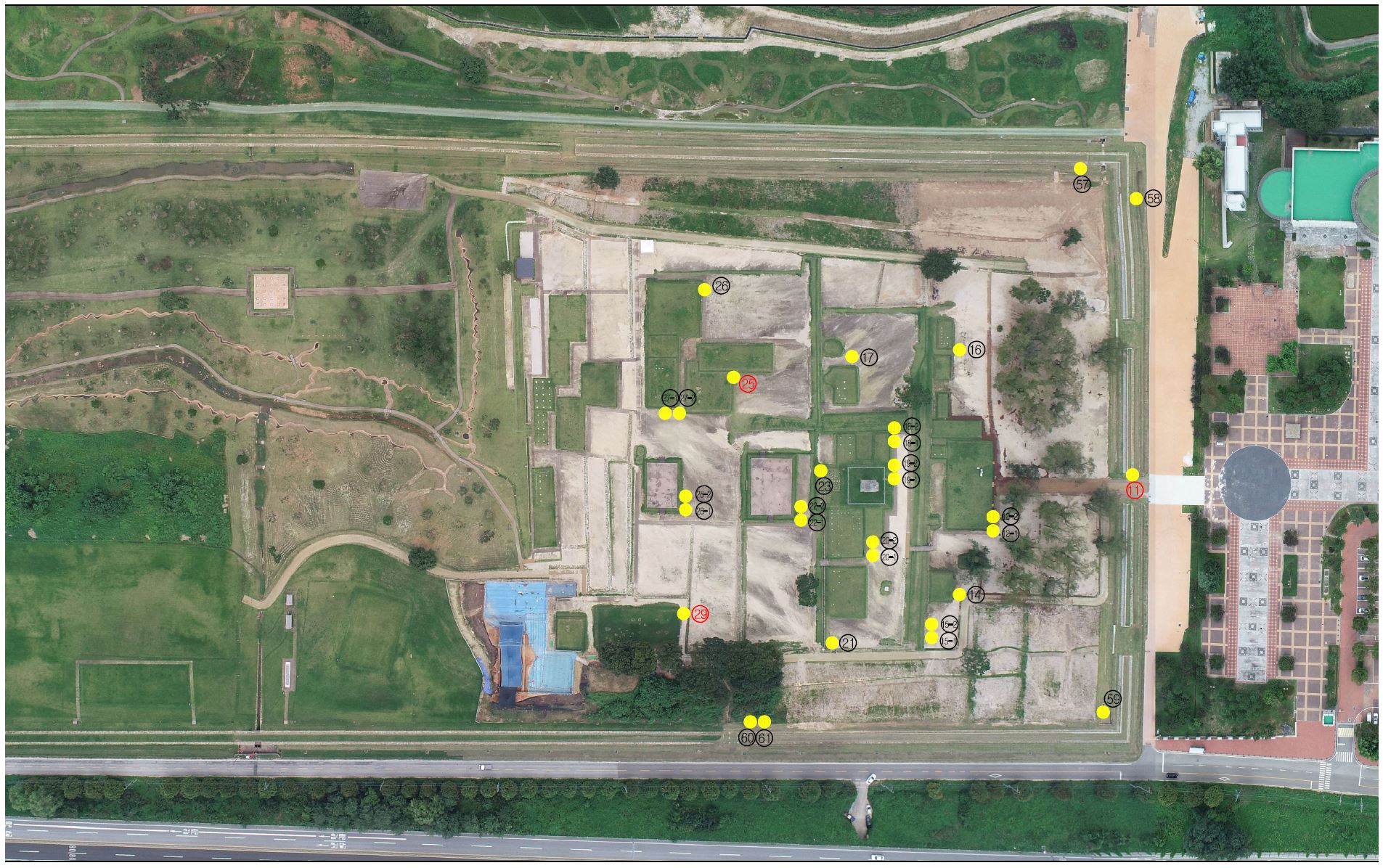익산 왕궁리 유적
| 익산 왕궁리 유적 Archaeological Site in Wanggung-ri, Iksan |
|
 익산 왕궁리 유적, 국가문화유산포털, 문화재청. |
|
| 대표명칭 | 익산 왕궁리 유적 |
|---|---|
| 영문명칭 | Archaeological Site in Wanggung-ri, Iksan |
| 한자 | 益山 王宮里 遺蹟 |
| 주소 | 전라북도 익산시 왕궁면 산80-1번지 외 ,금마면 동고도리 1109-8외 |
| 지정(등록) 종목 | 사적 제408호 |
| 지정(등록)일 | 1998년 9월 17일 |
| 분류 | 유적건조물/유물산포지유적산포지/육상유물산포지/선사유물 |
| 시대 | 백제 |
| 수량/면적 | 218,155㎡ |
| 웹사이트 | 익산 왕궁리 유적, 국가문화유산포털, 문화재청. |
|
|
|
해설문
국문
왕궁리유적은 백제 왕궁의 모습이 잘 남아 있는 궁성유적이다. 지난 30년 간의 조사에서 궁궐 담장과 정전, 정원, 후원, 화장실, 공방 등이 확인되어, 삼국시대 도성을 이해하는 데에 빼놓을 수 없는 대표 유적이다.
궁성은 동서 길이가 240여m, 남북 길이가 490여m의 장방형 궁장으로 둘러싸여 있다. 궁장의 폭은 3m가 넘고, 궁장 양쪽으로는 1m 폭으로 된 보도시설이 설치되어 있다. 궁성 내부의 전반부는 경사면을 따라 단이 지도록 4곳에 축대를 쌓아 대지를 평탄하게 만든 후, 정전건물인 대형건물, 와적기단 건물, 1동2실 구조 건물 등을 세웠고, 후반부 북동쪽의 높은 지대에는 후원을 두고, 북서편의 낮은 지대에는 공방과 화장실을 배치하였다.
대지 조성을 위한 대규모의 성토층과 동서 방향으로 쌓은 축대, 당대 최고의 위생시설을 갖춘 화장실과 금속공예 기술을 보여주는 공방 등은 삼국시대 궁성의 공간 구획과 활용 방식을 밝힐 수 있는 획기적인 자료로 평가된다. ‘首府(수부)’명 기와, 전달린 토기, 중국제 청자 편 등은 왕궁리유적의 위상과 중국과의 교류 등을 보여주는 중요 유물이다.
왕궁리유적은 백제 무왕 대에 궁성으로 건설되어 활용되다가 백제말 통일신라시대에 와서 1탑 1금당의 사찰로 변화되었다. 1965년에는 왕궁리오층석탑의 해체보수과정에서 사리장엄구가 발견되었다.
백제 왕궁의 구조를 온전하게 지니고 있는 왕궁리유적은 그 탁월한 가치를 인정받아 2015년에 유네스코 세계유산에 등재되었다.
영문
Archaeological Site in Wanggung-ri, Iksan
This archaeological site in Wanggung-ri is the former location of a detached palace built during the reign of King Mu (r. 600-641) of the Baekje kingdom (18 BCE-660 CE) to supplement the royal capital, Sabi (today’s Buyeo), located around 35 km to the north. During the Unified Silla period (668-935), it was turned into a Buddhist temple. The area includes the remains of the palace walls, main throne hall, main garden, rear garden, toilets, workshops, and other structures dating to its time as a Baekje royal palace, as well as a five-story stone pagoda (Treasure No. 289) which was found to contain Buddhist relics (Treasure No. 123) dating to the Goryeo period (918-1392). This site was inscribed on the UNESCO World Heritage List in 2015 as part of the Baekje Historic Areas.
The five-story stone pagoda was taken apart and reconstructed in 1965, and excavations of the site began in 1976. The site is surrounded by a 3 m-wide wall measuring 240 m from east to west and 490 m from north to south. On either side of the wall is a 1 m-wide pavement. The complex is built on a slight slope, and to accommodate this terrain, four east-west axis stone embankments measuring 0.5-2 m were utilized. By leveling out the area between the embankments, flat land for building was created. Located in front of the first embankment was a large building to be used as a throne hall, and in front of the third embankment was a building with a roof-tile foundation – a unique feature of Baekje architecture. In the back of the complex was a garden to the right, and workshops and toilets to the left.
The large-scale earthwork to level out the land, the embankments, the toilets which had the best hygiene facilities of the time, and the metal craftwork technology from the workshops provide insight into the planning and use of space in Baekje palaces. Artifacts excavated from the site include roof tiles with inscriptions referencing the capital, earthenware with an extended rim, and shards of Chinese celadon, which are evidence of the high status of this site and Baekje’s exchange with China.
개별 안내판
- 담장
- 건물
- 석축
- 사찰
- 기타
참고자료
- 익산 왕궁리 유적, 나의 문화유산 답사진, 다음 블로그, 2015.11.22. http://blog.daum.net/dojasa/16794853
